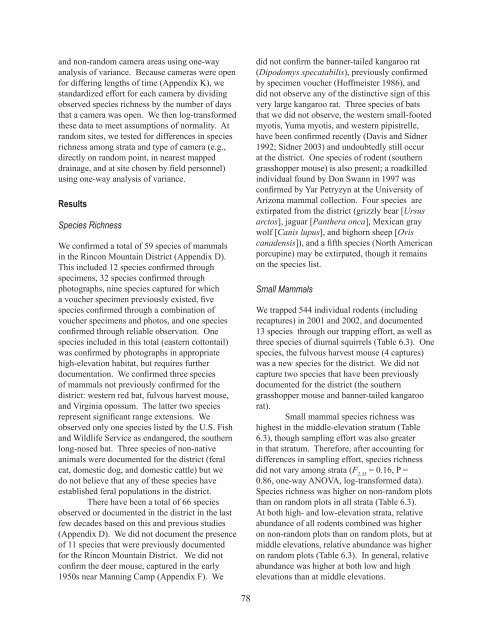Vascular Plant and Vertebrate Inventory of Saguaro ... - USGS
Vascular Plant and Vertebrate Inventory of Saguaro ... - USGS
Vascular Plant and Vertebrate Inventory of Saguaro ... - USGS
Create successful ePaper yourself
Turn your PDF publications into a flip-book with our unique Google optimized e-Paper software.
<strong>and</strong> non-r<strong>and</strong>om camera areas using one-way<br />
analysis <strong>of</strong> variance. Because cameras were open<br />
for differing lengths <strong>of</strong> time (Appendix K), we<br />
st<strong>and</strong>ardized effort for each camera by dividing<br />
observed species richness by the number <strong>of</strong> days<br />
that a camera was open. We then log-transformed<br />
these data to meet assumptions <strong>of</strong> normality. At<br />
r<strong>and</strong>om sites, we tested for differences in species<br />
richness among strata <strong>and</strong> type <strong>of</strong> camera (e.g.,<br />
directly on r<strong>and</strong>om point, in nearest mapped<br />
drainage, <strong>and</strong> at site chosen by field personnel)<br />
using one-way analysis <strong>of</strong> variance.<br />
Results<br />
Species Richness<br />
We confirmed a total <strong>of</strong> 59 species <strong>of</strong> mammals<br />
in the Rincon Mountain District (Appendix D).<br />
This included 12 species confirmed through<br />
specimens, 32 species confirmed through<br />
photographs, nine species captured for which<br />
a voucher specimen previously existed, five<br />
species confirmed through a combination <strong>of</strong><br />
voucher specimens <strong>and</strong> photos, <strong>and</strong> one species<br />
confirmed through reliable observation. One<br />
species included in this total (eastern cottontail)<br />
was confirmed by photographs in appropriate<br />
high-elevation habitat, but requires further<br />
documentation. We confirmed three species<br />
<strong>of</strong> mammals not previously confirmed for the<br />
district: western red bat, fulvous harvest mouse,<br />
<strong>and</strong> Virginia opossum. The latter two species<br />
represent significant range extensions. We<br />
observed only one species listed by the U.S. Fish<br />
<strong>and</strong> Wildlife Service as endangered, the southern<br />
long-nosed bat. Three species <strong>of</strong> non-native<br />
animals were documented for the district (feral<br />
cat, domestic dog, <strong>and</strong> domestic cattle) but we<br />
do not believe that any <strong>of</strong> these species have<br />
established feral populations in the district.<br />
There have been a total <strong>of</strong> 66 species<br />
observed or documented in the district in the last<br />
few decades based on this <strong>and</strong> previous studies<br />
(Appendix D). We did not document the presence<br />
<strong>of</strong> 11 species that were previously documented<br />
for the Rincon Mountain District. We did not<br />
confirm the deer mouse, captured in the early<br />
1950s near Manning Camp (Appendix F). We<br />
78<br />
did not confirm the banner-tailed kangaroo rat<br />
(Dipodomys specatabilis), previously confirmed<br />
by specimen voucher (H<strong>of</strong>fmeister 1986), <strong>and</strong><br />
did not observe any <strong>of</strong> the distinctive sign <strong>of</strong> this<br />
very large kangaroo rat. Three species <strong>of</strong> bats<br />
that we did not observe, the western small-footed<br />
myotis, Yuma myotis, <strong>and</strong> western pipistrelle,<br />
have been confirmed recently (Davis <strong>and</strong> Sidner<br />
1992; Sidner 2003) <strong>and</strong> undoubtedly still occur<br />
at the district. One species <strong>of</strong> rodent (southern<br />
grasshopper mouse) is also present; a roadkilled<br />
individual found by Don Swann in 1997 was<br />
confirmed by Yar Petryzyn at the University <strong>of</strong><br />
Arizona mammal collection. Four species are<br />
extirpated from the district (grizzly bear [Ursus<br />
arctos], jaguar [Panthera onca], Mexican gray<br />
wolf [Canis lupus], <strong>and</strong> bighorn sheep [Ovis<br />
canadensis]), <strong>and</strong> a fifth species (North American<br />
porcupine) may be extirpated, though it remains<br />
on the species list.<br />
Small Mammals<br />
We trapped 544 individual rodents (including<br />
recaptures) in 2001 <strong>and</strong> 2002, <strong>and</strong> documented<br />
13 species through our trapping effort, as well as<br />
three species <strong>of</strong> diurnal squirrels (Table 6.3). One<br />
species, the fulvous harvest mouse (4 captures)<br />
was a new species for the district. We did not<br />
capture two species that have been previously<br />
documented for the district (the southern<br />
grasshopper mouse <strong>and</strong> banner-tailed kangaroo<br />
rat).<br />
Small mammal species richness was<br />
highest in the middle-elevation stratum (Table<br />
6.3), though sampling effort was also greater<br />
in that stratum. Therefore, after accounting for<br />
differences in sampling effort, species richness<br />
did not vary among strata (F 2,35 = 0.16, P =<br />
0.86, one-way ANOVA, log-transformed data).<br />
Species richness was higher on non-r<strong>and</strong>om plots<br />
than on r<strong>and</strong>om plots in all strata (Table 6.3).<br />
At both high- <strong>and</strong> low-elevation strata, relative<br />
abundance <strong>of</strong> all rodents combined was higher<br />
on non-r<strong>and</strong>om plots than on r<strong>and</strong>om plots, but at<br />
middle elevations, relative abundance was higher<br />
on r<strong>and</strong>om plots (Table 6.3). In general, relative<br />
abundance was higher at both low <strong>and</strong> high<br />
elevations than at middle elevations.

















